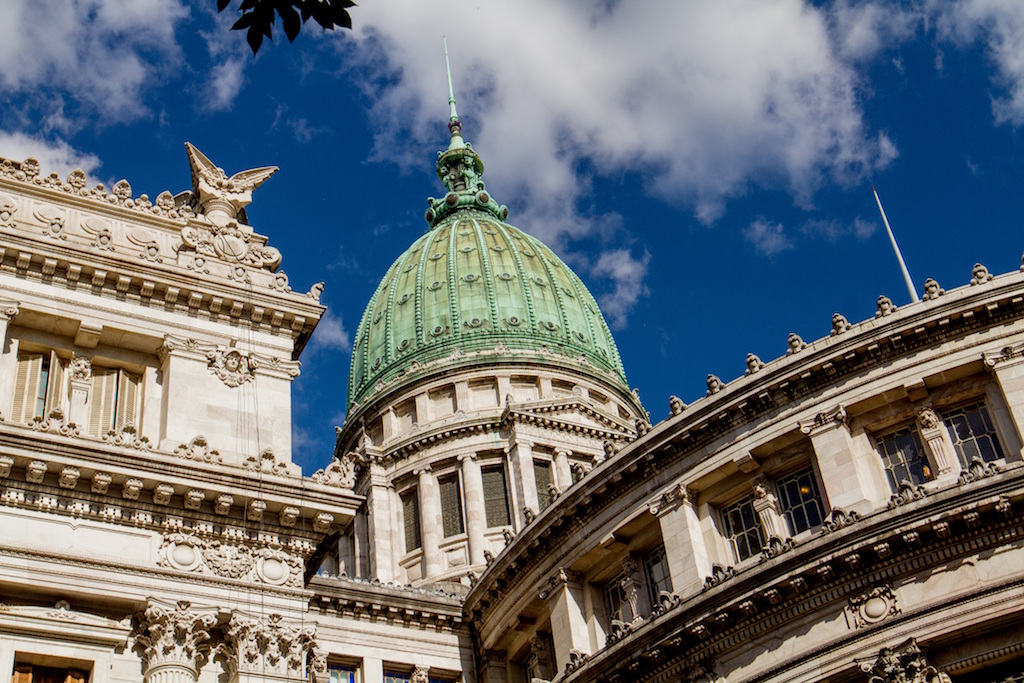[ad_1]

Congreso de La Nacion in Buenos Aires.
COURTESY THE CITY OF BUENOS AIRES
In a strip of untamed wilderness lining one of the most affluent neighborhoods of Buenos Aires, the Argentine artist Eduardo Basualdo led a group of collectors to his monumental public installation Perspective of Absence. After trodding down a shoddy wooden dock for nearly half an hour, his guests arrived to what felt like the edge of the earth, where a giant revolving door loomed over a blue horizon. If any of those guests stepped through the portal, they would have fallen into another realm—in this case the murky waters of the River Plata. “Argentina is a country that is always looking out,” Basualdo said of a national character embodied in the piece, in which yearning mingled with the potential of a wrong step that could cause a plunge into despair. “Everything we produce or earn, we export to keep it safe. That’s no way for our country to grow.”
During a balmy week at the beginning of September, as the last days of winter turned to spring, the new initiative Art Basel Cities descended upon Buenos Aires and turned that external outlook inward. The week-long event, which was part of a three-year engagement in the city, shuffled what Art Basel said were some 100 out-of-town collectors around Buenos Aires to see 18 public art installations, tour the city’s galleries, sit in on furtive discussions about the international art ecology, and mingle with local collectors and government officials. In the lead-up to the event, Art Basel Cities was touted as a chance to elevate different art communities around the globe and accelerate their growth on an international scale, with Buenos Aires as the first experiment in a program that would be implemented elsewhere too. But many wondered: Would it work?
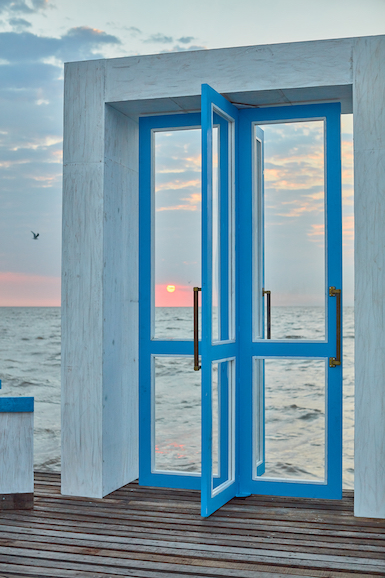
Eduardo Basualdo, Perspective of Absence.
COURTESY ART BASEL CITIES
Art Basel Cities was conceived primarily as a growth initiative for the international art fair based in Switzerland and expanded across the globe. “We decided quite a few years back that we were not going to have a fourth Art Basel show,” said Patrick Foret, the director of business initiatives for Art Basel, an enterprise that now also includes fairs in Miami Beach and Hong Kong. “However, we were regularly approached by cities who were attracted by our economic impact in the cities which host our shows.” After engaging different operators in those cities, Foret said, “We realized that there are vibrant art scenes out there with committed governments and passionate players and incredible artists who are not at the center of the art world and not having the impact they deserve to have.”
The hope beyond the bounds of the art world was that a boon for a certain sector could be a boon for the city as a whole. As András Szántó, a cultural consultant and one of the architects of the Buenos Aires program, put it, “The general thinking is that bringing culture into a city not only creates a cultural economy but benefits the entire economy.”
When the news of Art Basel Cities was announced in 2016, Buenos Aires was poised to welcome international investment and chart a more prosperous course for all of Argentina. After more than a decade under a protectionist government, Mauricio Macri had been thrust into power as president with help from a frustrated upper-middle class. Cognizant of the economic impact a platform like Art Basel could bring, the Macri administration was more than eager to position Argentina’s cultural scene on an international scale. “In many ways, we didn’t choose Buenos Aires—Buenos Aires chose us,” Foret said of a relationship brokered with government officials, heads of cultural institutions, gallerists, artists, and art entrepreneurs. “Argentina was coming out of a phase where it had folded in upon itself, and there was so much here that could be revealed.”
The strategy to hold Argentina up to the rest of the world was developed with three goals: to position the country’s cultural scene as a formidable option for international art collectors and curators, to unite cultural stakeholders so that they would work more closely together, and, finally, to engage the public to take part. “We wanted to make sure that we addressed the question of, when wealthy internationals collectors and institutions come to town, how do you have a dialogue of equals?” Szántó said. That dialogue among equals amounted to 65,000 local attendees, according to organizers, who participated in Art Basel Cities during its run from September 6 through 12.
To program the event, Art Basel selected Cecilia Alemani, the director and chief curator of High Line Art in New York and an organizer in the past of performance presentations and installations for the Frieze art fair. “What was decided within the program was that we would have an international curator, and, in her curation, she would have time to converse with artists to integrate works in the public realm,” Enrique Avogadro, Argentina’s Minister of Culture, said of the selection of an organizer from out of town. The result was “Hopscotch,” a city-wide exhibition that borrows its title from Julio Cortázar’s 1963 novel Rayeulos (Hopscotch) about the lives of expatriates as they move between Europe and their native Argentina.
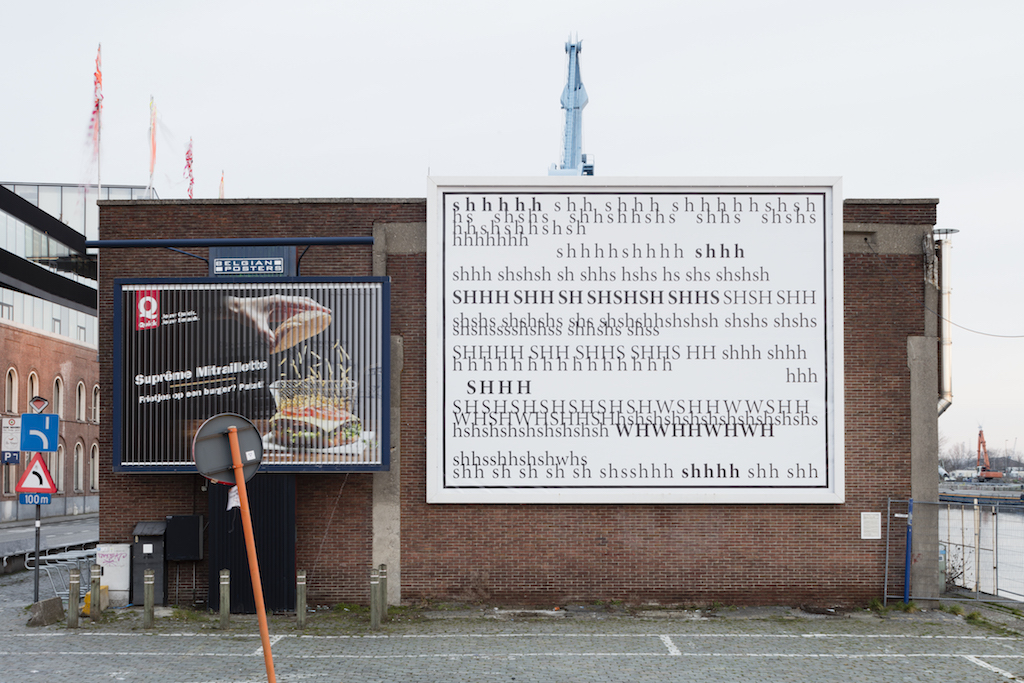
David Horvitz, When the Ocean Sounds, 2018.
MICHIEL DE CLEENE/COURTESY THE ARTIST AND CHERTLÜDDE, BERLIN
Buenos Aires covered the hefty price tag of reportedly more than $3 million to organize Art Basel Cities, with funding going to cover the production of artworks as well as Art Basel’s fee, which local reports, drawing on public records, have cited as $2.1 million. (Art Basel would not comment on either the program’s total budget or its fee.) Since Buenos Aires was selected in 2016, Argentina has fallen precipitously into a cycle of currency devaluation. By the time “Hopscotch” opened, the country had experienced a 50-percent devaluation of the Argentinean peso in the previous year, with an astounding 13-percent drop during the week of Art Basel Cities. Unemployment and public unrest have surged. Deep in the throes of an economic crisis, the timing for an international art party was hardly fortuitous—so much so that it was no wonder when a local collector, Elena Lidl, took to the media the day the event was launched to proclaim that the government’s outlay of public funds merely “bought smoke.”
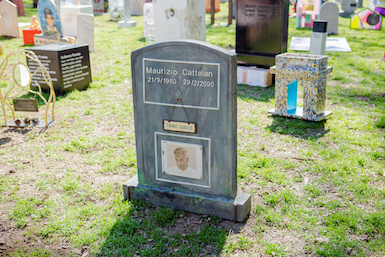
Maurizio Cattelan, Eternity, 2018.
COURTESY ART BASEL CITIES
The city’s investment, Lidl argued, would do little to boost the local economy. But that contention was not shared by all. “Argentines will complain that the government doesn’t invest in our culture, and then when they do, they’ll complain that we can’t afford it,” said Orly Benzacar, the director of Ruth Benzacar gallery in the trendy Palermo neighborhood of Buenos Aires. Though Benzacar was quick to point out that sales are her main focus as an art dealer, she said that a cultural immersion program can have an important impact on the reach of her artists. “Our geopolitical situation keeps us far from everything, so moving art and people becomes very expensive,” she said, noting great difficulty and expense in accessing international collectors. “During this program, I met people I didn’t know before, and there’s a lot of positive interest.”
Inés Starc, a director at Barro gallery near the La Boca neighborhood, said that any benefits from the program would take time to come to fruition. “A lot of times a conversation with someone can lead to one of our artist’s work being in a show abroad, which significantly impacts the price of the artist’s work,” she said of working with a roster that includes painter Joaquín Boz and sculptor Agustina Woodgate. “That’s very important for us.”
Avogadro, the culture minister, pointed to the prospect of general attention for Argentina as an indicator of success. “International awareness is one important measurement,” he told me. “Buenos Aires has had an extensive amount of press coverage internationally thanks to Art Basel Cities, which is wonderful for the Buenos Aires trademark. On our own, this visibility would have been impossible to achieve.” Avogadro said that, to his knowledge, some 240 of the 300 collectors who attended Art Basel Cities had never visited the city before, and their visit had a direct economic benefit on scores of local businesses beyond the cultural framework. “These are people who are very well connected on an international level.”
For the local artists and performers selected to participate in Art Basel Cities, the program was a welcome occasion. Gabriel Chaile, whose work is often critical of the current government, said he appreciated the viewership the program brought his way. For Art Basel Cities, he produced Diego, a large-scale adobe sculpture that doubled as a clay oven to bake empanadas while drawing attention to the controversial police shooting of local youth Diego Núñez. “Certain museum shows have put my work on the map, so a program like this obviously has its benefits,” Chaile said.
International artists who participated in Art Basel Cities hired local performers for their installations. Alexandra Pirici’s moving Aggregate enlisted 60 locals to enact motions and sounds in reference to their cultural heritage for four hours a day, with the group moving as a swarm that drifted through Arenas Studios, an industrial electrical plant that once powered the Port of Buenos Aires. For another work, Eternity—described as a “cemetery for the living” in the middle of one of Buenos Aires’s most highly trafficked parks—Maurizio Cattelan commissioned local artists to create tombstones, who responded with works bearing messages like “Salary: It Always Arrived at the End of the Month” and a replica of a Barbie Doll box with a phrase scrawled on the front: “Life in plastic, it’s fantastic.” For his piece titled Kermit the Frog, Even, Alex Da Corte enlisted a team of local performers interacting with a humongous runaway parade float.
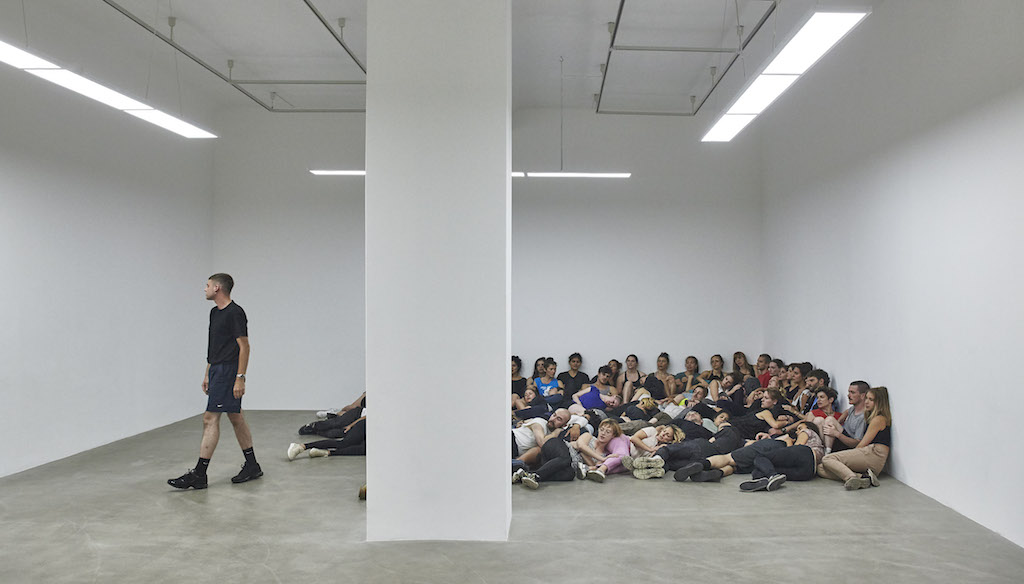
Alexandra Pirici’s Aggregate at Neuer Berliner Kunstverein.
JOSEPH DEVITT TREMBLAY/COURTESY NEUER BERLINER KUNSTVEREIN.
Among the program’s goals was to stir up dialogue and discussion. “Some of the short-term impacts are the number of talks and masterclasses that contribute to the transfer of expertise to the local art scene,” Foret, the Art Basel director, said of a talks program designed to serve as a year-round component of Art Basel Cities. With a focus on the professionalization of the art world, more than 20 discussions were held over the past year with international visitors like Hans Ulrich Obrist and New York-based artist Juliana Huxtable. In addition to cultural currency, Foret counted among the program’s successes sponsorship revenue from companies that have not contributed to the arts in Argentina previously, including the Swiss bank UBS and the watchmaker Audemars Piguet.
Foret acknowledged that the long-term impact of Art Basel Cities will be hard to measure, as it will depend on “connections and relationships established that will result in revenue opportunities through cultural exchange and sales.” But given that the program was designed to expand the reach of Argentine artists and institutions, will the initiative lead to increased investment in the Argentine art market?
Miwa Taguchi, a Japanese collector who attended Art Basel Cities, said in an interview at the Museo de la Cárcova that her experience was “extremely special” and would likely add to her collection of art from Argentina. But she also said she doesn’t know when she might return to Buenos Aires. “I wouldn’t have necessarily come here if it weren’t for Art Basel Cities,” Taguchi said, “and I think some of the galleries that participated should consider participating in more international art fairs.”
Her comment highlighted a bind for many local galleries: with the cost of participating in art fairs ailing the art world at large, it’s even more difficult for operations in an emerging market in which works rarely sell for more than $45,000. “Argentina’s collector base is growing, but I think [a lack of] penetration in the international market is one of the principal factors for prices not rising,” Benzacar, the dealer, said. While her gallery has participated in Art Basel Miami Beach since 2002, she noted that a poor performance there could effectively close down her business. “It’s becoming very difficult for us to keep going to that fair. The price for Argentine art hasn’t risen in the same way.”
If the Art Basel Cities program is intent on becoming integral to the cultural evolution of Buenos Aires—or any city, for that matter—conversations with local stakeholders suggest that its next iteration should be primed to encourage sales. Avogadro said one way to do so would be to program a 2019 edition for Buenos Aires around ArteBA, the city’s international art fair. “We would love to build an Art Basel Cities art week around the fair, so in that way we’re endorsing this 27-year-old event and encouraging more international participation,” he noted.
Next year’s plan for Art Basel Cities in Buenos Aires is not yet clear. The program will come to an end in 2019, and the Art Basel team has yet to announce a second city to take part. In the meantime, organizers have commissioned a report, to be delivered next year, with the aim of measuring the impact of the program. “We’re spending a lot of time documenting conversations that started, relationships that have started,” Szántó said.
Different participants, as could be expected, maintain different desires. “I’m hoping this will broaden my market and bring more business, that my artists are better known, and that they penetrate first world markets,” Benzacar said. For a city that has grown weary of empty promises, such targets will come in for close scrutiny in time. “What did this event produce for us in a concrete sense? What deals are we able to close thanks to this event?” Benzacar asked. “Only time will tell.”
[ad_2]
Source link

